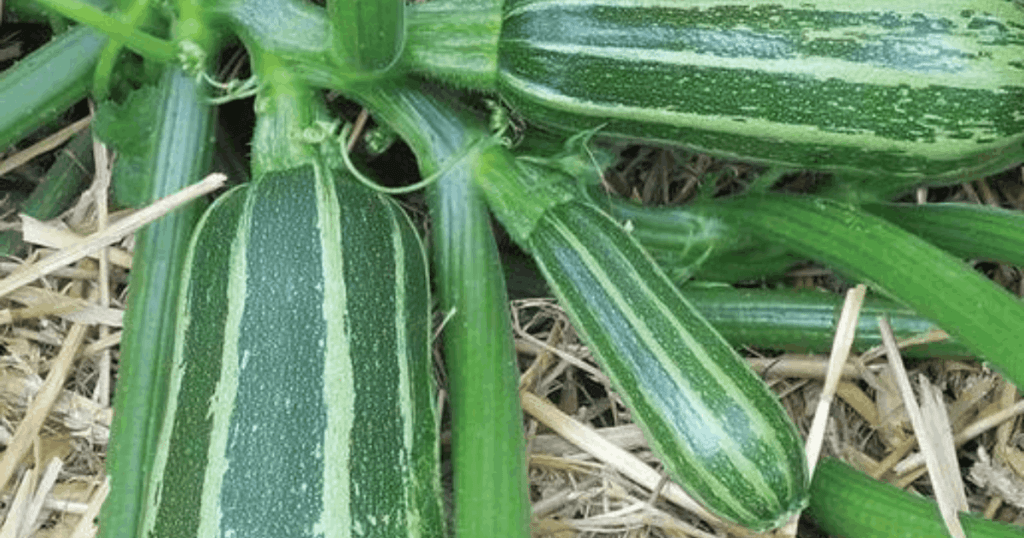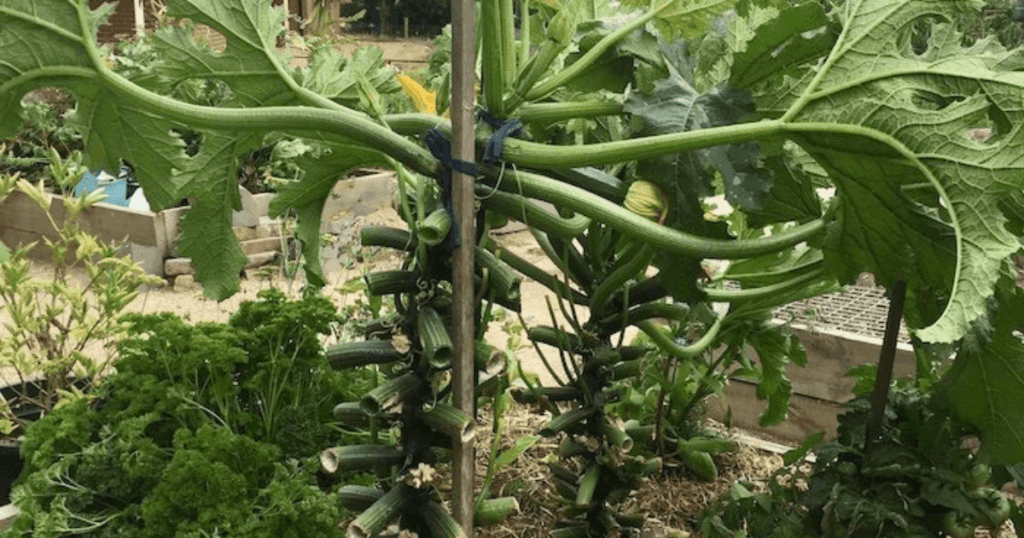Growing zucchini vertically is an effective way to maximize garden space and promote healthy plant growth. This method helps improve air circulation, reduces pest problems, and makes harvesting easier. Here’s a step-by-step guide on how to grow zucchini vertically in your garden.
Benefits of Growing Zucchini Vertically
Maximizes Space
Vertical gardening allows you to use less ground space, making it ideal for small gardens or urban environments. You can plant more vegetables in the same area by training zucchini plants to grow upwards.
Improves Air Circulation
Growing zucchini vertically helps improve air circulation around the plants, reducing the risk of fungal diseases. Better airflow keeps the leaves dry and less susceptible to mildew and other moisture-related issues.
Eases Harvesting
When zucchini grows vertically, the fruits are easier to spot and pick. This reduces the chances of missing mature zucchinis, which can quickly become oversized and tough if left on the plant for too long.
Reduces Pest Problems
By lifting the plants off the ground, you can reduce the likelihood of pests such as slugs and snails attacking your zucchini. This method also makes it easier to spot and remove any pests that do appear.
Choosing the Right Varieties For Growing Zucchini Vertically
Not all zucchini varieties are suitable for vertical gardening. Look for:
- Bush varieties: These compact plants are ideal for vertical growth.
- Smaller fruit varieties: Lighter fruits put less strain on the vines.
Some good options include:
Not all zucchini varieties are suitable for vertical gardening. Select varieties known for their compact or bush growth habits. Here are some excellent options for growing zucchini vertically:
1. Black Beauty

Description: Black Beauty is a classic zucchini variety known for its dark green skin and robust flavor. It grows well vertically and produces high yields. Advantages:
- Compact growth habit
- Prolific producer
- Resistant to common pests and diseases
2. Raven

Description: Raven zucchini is known for its compact growth and tender, flavorful fruits. It has nearly black skin, which makes it visually appealing. Advantages:
- Bush-type plant suitable for vertical growing
- High yield
- Tender and flavorful fruits
3. Bush Baby

Description: Bush Baby is a smaller, bush-type zucchini variety that is perfect for vertical gardening. It produces small, tender zucchinis that are ideal for fresh eating or cooking. Advantages:
- Compact size, ideal for small spaces
- Produces uniform, tender fruits
- Easy to grow and maintain
4. Patio Star

Description: Patio Star is a zucchini variety bred specifically for small spaces and container growing. It has a bush habit that lends itself well to vertical gardening. Advantages:
- Compact bush habit
- Great for containers and small gardens
- Consistent, high-quality fruits
5. Spacemiser

Description: Spacemiser is a compact zucchini variety that produces an abundance of small, tasty zucchinis. It is well-suited for vertical growing due to its bushy growth habit. Advantages:
- Space-efficient
- High-yielding
- Suitable for vertical structures
Preparing the Soil
Zucchini plants need rich, well-draining soil to thrive. Follow these steps to prepare your growing area:
- Choose a sunny spot with at least 6-8 hours of direct sunlight daily.
- Loosen the soil to a depth of 12-15 inches.
- Mix in 2-3 inches of compost or well-rotted manure.
- Ensure the soil pH is between 6.0 and 7.5.
If growing in containers, use a large pot (at least 5 gallons) filled with high-quality potting mix.
Preparing Your Vertical Growing System
To start growing zucchini vertically, you’ll need a sturdy support structure. Options include:
1. How to Grow Zucchini Vertically Using Trellis

A trellis is a simple frame made of wood or metal, often fitted with lattice or wire mesh. This structure provides a stable framework for zucchini plants to climb.
Materials Needed
- Wooden or metal posts
- Lattice or wire mesh
- Fasteners (nails, screws, or zip ties)
Construction Steps
- Install Posts: Drive the wooden or metal posts into the ground at each end of the planting row. Ensure they are firmly anchored to support the weight of the plants.
- Attach Lattice or Mesh: Secure the lattice or wire mesh to the posts using fasteners. The mesh should be taut and sturdy enough to support the vines.
- Train the Vines: As the zucchini plants grow, guide the main vine up the trellis. Use soft ties to secure the vine to the mesh, being careful not to damage the plant.
Advantages
- Easy to construct and customize.
- Provides excellent support for climbing plants.
- Improves air circulation around the plants.
2. How to Grow Zucchini Vertically Using Tomato Cage

Tomato cages are large, sturdy wire structures designed to support individual plants. They are readily available and easy to use.
Materials Needed
- Large tomato cages
Construction Steps
- Place the Cage: Position a tomato cage around each zucchini plant while it is still young.
- Guide the Vines: As the plant grows, gently guide the vines through the openings in the cage. Secure with soft ties if necessary.
Advantages
- Simple and quick to set up.
- Provides strong support for individual plants.
- It is ideal for gardeners with limited time or DIY skills.
3. Growing Zucchini Vertically Using A-frame

An A-frame trellis consists of two trellises leaned together to form an A-shape. This structure is sturdy and provides ample space for plants to climb.
Materials Needed
- Two trellises (wood or metal)
- Hinges or fasteners
- Additional support stakes (optional)
Construction Steps
- Build Trellises: Construct two identical trellises using wood or metal.
- Join Trellises: Connect the tops of the trellises with hinges or fasteners to form an A-shape.
- Secure in Place: Drive additional support stakes into the ground at the base of each trellis to prevent tipping.
- Train the Vines: As the zucchini plants grow, guide the vines up the sides of the A-frame.
Advantages
- Very stable and strong structure.
- Provides a large growing area for multiple plants.
- Can be easily disassembled and stored when not in use.
4. How to Grow Zucchini Vertically Using a Fence

An existing fence can be utilized as a support structure for growing zucchini vertically. This is a cost-effective option if you already have a suitable fence in your garden.
Materials Needed
- Existing fence (wood, metal, or wire)
- Soft ties or plant clips
Construction Steps
- Check the Fence: Ensure the fence is sturdy and in good condition.
- Plant Near the Fence: Plant zucchini seeds or seedlings close to the base of the fence.
- Train the Vines: As the plants grow, guide the vines to climb up the fence. Secure the vines with soft ties or plant clips as needed.
Advantages
- Utilizes existing structures, reducing the need for additional materials.
- Saves space by integrating the garden with existing fences.
- Provides strong support for climbing plants.
5. Grow Zucchini Vertically Using Stakes

Stakes are simple, vertical supports driven into the ground next to each plant. This method is straightforward and effective for supporting individual zucchini plants.
Materials Needed
- Sturdy stakes (wood, metal, or plastic)
- Soft ties
Construction Steps
- Drive Stakes into Ground: Place a stake next to each zucchini plant, ensuring it is driven deep enough to remain stable.
- Secure the Vines: As the zucchini grows, gently tie the main vine to the stake using soft ties. Adjust the ties as the plant grows to keep it supported.
Advantages
- Simple and inexpensive.
- Easy to install and adjust.
- Suitable for individual plants.
Planting and Training Zucchini
Now that your growing area is ready, it’s time to plant and start training your zucchini:
- Plant seeds directly in the soil after the last frost date, or start them indoors 3-4 weeks earlier.
- Space plants 2-3 feet apart if growing multiple zucchini vertically.
- As the plants grow, gently tie the main stem to your support structure using soft plant ties or twine.
- Guide side shoots and leaves onto the support as they develop.
- Prune excess foliage to maintain good air circulation.
Remember, growing zucchini vertically requires regular attention to training and pruning.
Ensuring Adequate Support
Regardless of the structure you choose, it’s important to ensure that it is tall and sturdy enough to support the weight of mature zucchini plants and their fruit. Here are some key considerations:
Height
- Minimum Height: Ensure the structure is at least 5-6 feet tall to accommodate the growth of the zucchini plants.
Stability
- Anchoring: Secure the structure firmly in the ground to prevent it from tipping over. This may involve driving posts deep into the soil or using additional support stakes.
- Weight Support: The structure should be able to support the weight of the zucchini vines and fruits, which can be substantial.
Materials
- Durability: Use materials that are durable and weather-resistant. Treated wood, galvanized metal, and sturdy plastic are good choices.
- Soft Ties: Use soft ties or plant clips to secure the vines to the support structure. Avoid using materials that can cut into the plant stems.
Managing Pests and Diseases
Common Pests

- Squash Bugs: Handpick and dispose of squash bugs and their eggs.
- Cucumber Beetles: Use row covers to protect young plants and apply insecticidal soap if needed.
- Aphids: Spray plants with a strong jet of water or use insecticidal soap to dislodge aphids.
Common Diseases

- Powdery Mildew: Appears as white powdery spots on leaves. Improve air circulation and apply fungicides if necessary.
- Downy Mildew: Causes yellowing and wilting of leaves. Remove affected leaves and apply appropriate fungicides.
- Bacterial Wilt: Spread by cucumber beetles. Control beetle populations to prevent the disease.
Growing zucchini vertically is an effective method to maximize garden space and promote healthy plant growth. You can enjoy a bountiful harvest of delicious zucchini by choosing the right varieties, preparing your garden properly, and providing consistent care.


